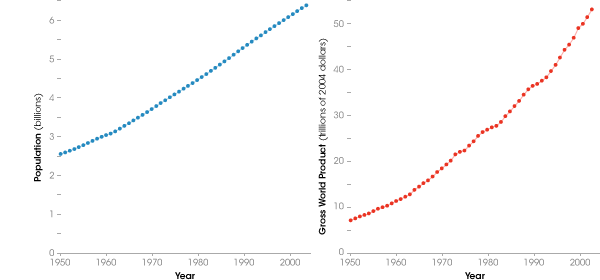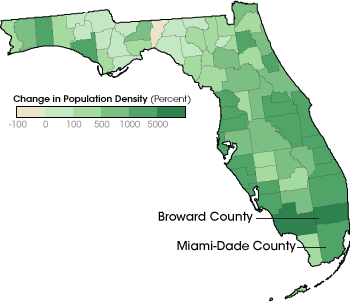

The “Nature” of the Problem: Population and Natural Disasters | |||
Between 1950 and 2003, the world’s population grew from an estimated 2.5 billion to 6.3 billion, according to the U.S. Census Bureau. More people are affected by natural disasters today because there are more people in the world to be affected. But beyond basic statistics, natural disasters may be getting more expensive because more people are building more expensive infrastructure in areas that are prone to natural disasters, like coastal areas, fire-prone forests, steep mountain slopes, and riverbanks. If disasters are having a greater impact today, says Patzert, the culprit is not Mother Nature, it’s human nature. |
|||
 | |||
Human factors like population density and where we choose to live can certainly account for the rising cost of hurricanes. In a paper published in Weather and Forecasting in 1998, Roger Pielke, Jr. and Christopher Landsea analyzed the cost of hurricanes in the United States between 1925 and 1995. “With respect to hurricanes,” they concluded, “the clearest evidence that explains increases in losses is changes in society, not in climate fluctuations.” Among these changes in society, “goods and machinery are more susceptible to damage,” says Mark Gryc, Vice President and Chief Engineer at FM Global, the world’s largest commercial and industrial property insurer. He notes that everything from greeting cards to manufacturing equipment is now equipped with delicate computer electronics that cannot be repaired as easily as the mechanical machinery of the past. Also, business has become more efficient, making downtime more expensive now than it was in the past. Finally, more people and businesses are located in hazardous areas. As Pielke and Landsea observed, more people lived in south Florida’s Miami-Dade and Broward counties in 1990 than in the entire 103 counties along the hurricane-prone Atlantic and Gulf coasts from Texas through Virginia in 1930. |
The Earth’s population increased rapidly during the 20th century, exposing more people to natural hazards. During the same period the value of goods and services produced globally increased even more swiftly. So far, the growth of population and increased global wealth accounts for the increased costs of natural disasters. (Graphs by Robert Simmon, based on data provided by the U.S. Census Bureau (left) and the Worldwatch Institute (right). | ||
 |
From 1930 to 2000, the population of Broward County, Florida, increased from 20,000 to 1,600,000 (8,000 percent), while Miami-Dade County rose from a population of 130,000 to 2,300,000 (1,800 percent). During the same period, the population of the United States as a whole only rose from 120,000,000 to 280,000,000 (230 percent). Americans are moving disproportionately into hurricane-prone areas. (Map courtesy U.S. Census Bureau) | ||
Why would people put themselves in harm’s way? “People like to be near the beach and nice landscapes,” says Roger-Mark De Souza, the technical director of the Population, Health, and Environment Program of the Population Reference Bureau. “In the United States, we have a perception that we can adapt and that the risk is not immediate,” says De Souza. Indeed, as humanity’s knowledge of science has increased, we have developed the ability to provide early warning for disasters like hurricanes and volcanic eruptions. Engineering has improved the design of buildings to minimize many risks. These factors in mind, it’s possible that the risk of living in a disaster-prone area doesn’t seem as significant to people as the benefits. “We know it’s a risk, but we [believe we] can deal with it,” says De Souza. |

As forecasters’ ability to predict hurricanes improves, and buildings become more resistant to high winds and waves, people become more comfortable accepting the risk of living on the coast, even though hurricanes continue to batter these areas. (Photograph courtesy Federal Emergency Management Agency Photo Library) | ||